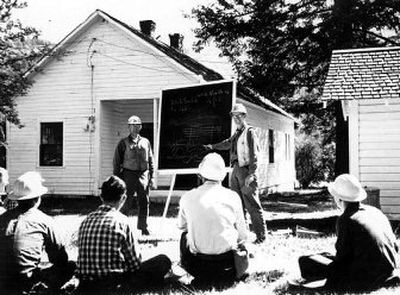New district offered new challenges for rangers

Editor’s note: This is the last in a series of reminiscences about the early days of the U.S. Forest Service in honor of the agency’s centennial in 2005. It was prepared by Handle Extra correspondent Carl Gidlund, a retired smokejumper and Forest Service public affairs officer.
This installment is drawn from the reminiscences of Edward G. Stahl, who took the first civil service exam for forest ranger at Kalispell, Mont., in 1905. He resigned from the agency on Jan. 1, 1911, and moved to British Columbia. Stahl wrote his recollections in 1953 and died about 1957.
(In 1908) I received instructions to proceed to a new district north of Bonners Ferry, Idaho. The supervisor, Dave Kinney, advised me that there would be considerable business there, with grazing permits and timber sales to look after.
Later I built a ranger cabin in the Moyie Valley near Snyder Post Office. Artman Snyder was ranger of the Moyie District when I arrived there. Snyder Post Office was named after him. He was a big, raw-boned fellow and had prospected from Mexico to Alaska.
He had a voice like a foghorn and told some pretty far-fetched yarns of his experiences, in a very serious manner, and seemed peeved if we doubted him. He said when he went to the Klondike via Edmonton, he lived 12 days on tallow candle and porcupine, then cut the dog’s tail off, made soup of it and fed the bone to the dog. Very generous. (It helped the dog make both ends meet.)
Later in the summer, Art Snyder and Glen Smith took a shortcut across the hills from Snyder Ranger Station to Bonners Ferry. They were both big men, about 6 feet tall, but there the similarity ended. Art was spare of frame, rugged, with dark features, lined and browned from life in the open, while Glen Smith was of florid complexion and inclined to carry surplus weight.
They carried no lunch and from running and battling mosquitoes, they developed an enormous hunger. The first settler’s place they reached was George Fry’s, but no one was home. They found a lard pail full of separated cream in the spring and drank the works. After running downhill for some time Art Snyder stopped and remarked, “I believe my stomach is a solid lump of butter.”
He turned pale, sat down on a log, and made noise that sounded like “New York.” After he had coughed up considerable buttermilk, they resumed their journey. Mrs. Fry told me she met them on the road, and when she refused their offer to pay for the cream, she had no idea they had consumed it all.
The duties of a forest ranger were many and varied, so the work was interesting and never onerous. One assignment the writer disliked was reporting on the validity of homestead claims within the National Forest. A forest ranger was authorized to take affidavits and administer oaths, as an agent of the General Land Office, in the prosecution of fraudulent claims. Forest rangers in Idaho also acted as deputy state game wardens.